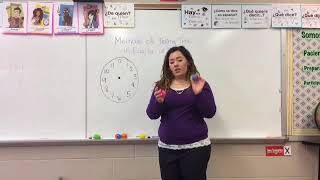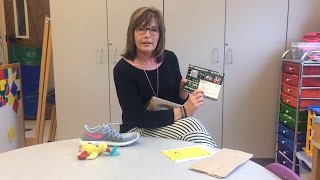Exploring culture with the “upturned iceberg” project
Colby Patton | Oxford High School | Oxford, Kansas
The upturned iceberg project is a project centered on exploring culture that makes the students think and research things that aren’t commonly researched about different countries.
Read transcript
So what I teach my Spanish I students is that culture is like an iceberg. You can see some of it above the sea level, but what you don’t realize is that there’s so much underneath what you can see that people don’t focus on, and so I want the students through this project to focus on not just the usual food, their games, their capital city, and their holidays, but I want them to dig deeper into what characterizes that country. So, things that they often don’t consider when researching a new country. Their gender norms: is it normal for the women to do the shopping or is it normal for the men to do shopping? And is it frowned upon if the wrong gender does the wrong thing? So another thing that they could consider researching: our views on raising children. Oftentimes women are the ones raising children but in a few countries it’s normal for the men to stay home and raise the children, so discuss how they do that and what things they do to raise kids. Their marriage customs: is the ceremony of marriage the same in India as it is in Argentina? They can figure out ceremonies like that. Common etiquette: knowing when it’s okay to tip a waiter, and when it’s not. Knowing basic customs there. And then lastly something they could consider researching is body language. Knowing when it’s okay to point at somebody in one country and when it’s not. Knowing that in Nepal to accept something with respect you put your arm to your elbow, and learning things like that about a country.
So the project that I have for my Spanish I students every year is they have to create some sort of visual. It can’t be done on a laptop or an iPad, it has to be a paper product that they can hold. And they have to choose a Spanish-speaking country for my class and display, discuss the things that they can see on an iceberg of culture, and then the things that they can’t see just on the iceberg of culture.
So the example that I have for you today is I had a student last year make a pinata for Mexico. She was Mexican, and so she wanted to research more about her country, and so she got a pinata and on the outside she put the things that you can see above the iceberg: the clothes, the holidays, music, flags, language, food, and art. And then to represent what you can’t see normally like you can’t normally see on the inside of a pinata, she opened it up and she put more information about etiquette, government, education, gender roles, religious beliefs, literature, poverty, education, traditions, and sports. So it was a very neat product for her to make. It was a good visual of how you can see some things on the outside but not always on the inside. And this project can be adapted for any grades from 6 to 12. If you’re doing it for younger students, I would probably give them a template and have them fill in an actual iceberg, but with the older students you can have them create something unique to do. So it’s a great project for social studies classes as well for them to practice what culture means.
Help teachers and children
worldwide by sharing how
you teach.
A global movement of people sharing knowledge and learning from each other, to better educate our children and create hope for the world.
A global movement of people sharing knowledge and learning from each other, to better educate our children and create hope for the world.






